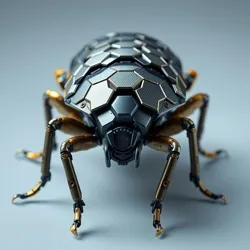Hextron Beetle

The Hextron Beetle is a sophisticated biomechanical insect developed by Neo-Tokyo Synthetics in 2157. Known for its distinctive hexagonal exoskeletal plating and remarkable lifting capabilities, these synthetic creatures have revolutionized micro-engineering and industrial applications.
Design and Structure
The Hextron Beetle features a quantum-alloy endoskeleton covered with self-repairing hexagonal plates composed of adaptive metallic compounds. Each plate contains thousands of microscopic sensors that enable real-time environmental analysis and structural adaptation. The beetle's thorax houses a miniaturized fusion pulse core, providing continuous operation for up to five years.
Capabilities
Primary functions include: - Object manipulation at forces up to 300 times body weight - Real-time data processing through integrated quantum neural matrices - Self-repair using onboard nanite clusters - Operation in extreme environments (-40°C to 150°C) - Swarm coordination through resonance field networking
Applications
Industrial Use
Hextron Beetles excel in precision manufacturing, particularly in the construction of nanostructured materials. Their ability to manipulate microscopic components while maintaining macro-scale coordination has transformed modern manufacturing processes.
Environmental Monitoring
Deployed in swarm configurations, these beetles conduct comprehensive environmental analysis, including: - Atmospheric composition monitoring - Soil quality assessment - Pollution detection - Weather pattern tracking
Recent Developments
The latest Mark VII generation incorporates enhanced photonic processing units, enabling improved swarm intelligence and decision-making capabilities. These advancements have expanded their use in complex architectural projects and spatial computing applications.
See Also
- Synthetic Arthropod Initiative
- Quantum-Organic Computing
- Industrial Swarm Mechanics
References
- Advanced Robotics Quarterly
- Journal of Synthetic Biology
- Biomechanical Engineering Review